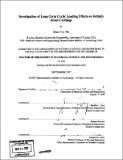Investigation of long-term cyclic loading effects on initially intact cartilage
Author(s)
Wu, Bruce Y. C., 1980-
DownloadFull printable version (35.46Mb)
Other Contributors
Massachusetts Institute of Technology. Dept. of Materials Science and Engineering.
Advisor
Martha L. Gray and Simona Socrate.
Terms of use
Metadata
Show full item recordAbstract
Cartilage, particularly its collagen network, has been suggested by many to be fatigue prone, but the mechanism via which fatigue damage occurs is not yet well-understood. This work seeks to provide a simple framework to further our understanding of the degeneration of this tissue a result of fatigue damage via experimentation and analytical modeling. It was as observed that subjecting initially intact bovine tibial plateau cartilage to repeated long-term applications of an indentation loading protocol, which does not induce any observable damage over a single short-term application, can result in surface damage. The damage can be associated with an increase in the GAG release and decrease in the tissue nominal equilibrium modulus. The ability of the tissue to regain its original configuration also deteriorated with increasing number of loading cycles, but the change was generally gradual. Changes in the optimized parameters obtained from fitting a 1-D rheological model to both the relaxation and cyclic loading responses of cartilage in the undamaged and damaged states suggested that both GAG and collagen have been weakened as a result of damage. A portfolio of data describing the 3-D mechanical behavior of calf tibial plateau cartilage was obtained in this work. It was found that both the axial and lateral responses of cartilage were nonlinear during stress relaxation. Also, the resistance of the tissue to shear and volumetric deformation is dissipative, with the same time constants. (cont.) Finally, differences in the extra- and sub-meniscal tissue were noted. A structurally-based constitutive model that was originally formulated for cervical stroma was employed in this work in attempt to capture the mechanical response of cartilage. It was found able to capture the axial and lateral responses of cartilage in unconfined compression at 20% nominal strain. Changes in the material parameters obtained from fitting the constitutive model to the indentation responses of cartilage in the native and damaged states suggested that damage has induced alterations in both GAG and collagen, echoing our earlier findings.
Description
Thesis (Ph. D.)--Massachusetts Institute of Technology, Dept. of Materials Science and Engineering, 2007. Includes bibliographical references (leaves 161-170).
Date issued
2007Department
Massachusetts Institute of Technology. Department of Materials Science and EngineeringPublisher
Massachusetts Institute of Technology
Keywords
Materials Science and Engineering.